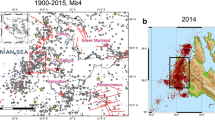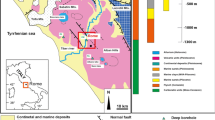Abstract
A reliable site characterization of a seismic monitoring station helps in the objective determination of the local magnitude. Therefore, 17 broadband stations of the Algerian seismic monitoring network, installed in various geological and topographic contexts, were selected to estimate site responses using earthquake and ambient vibration data. Results showed that most stations exhibited site-effects. At the Neogene topographic surface stations, the site response showed two frequency peaks. The first in low-frequency domain was observed at higher altitudes and varied inversely with elevation along a profile across the structure, which might be related to lithological site-effects. The second high-frequency peak, which is nearly constant along the profile, was also observed in the Mesozoic/Paleogene structures. This amplification was explained by the topographic site-effects. Based on these findings, deconvolution of the non-flat site responses of the studied stations from the seismic recording is recommended before any seismological application. It is shown that the seismic bedrock of northern Algeria is primarily Mesozoic, with shear wave velocity ≥ 1500 m/s.










Similar content being viewed by others
Data availability
The datasets analyzed during the current study are not publicly available due to be not opened to the public yet, but are available from the corresponding author on reasonable request.
References
Amrouche M, Yamanaka H, Chimoto K, Dhakal YP (2014) Near-surface geophysical profiling near former location of K-NET Tsukidate strong motion station in Miyagi Prefecture, Japan. J Disaster Res 9:709–718
Beldjoudi H., Guemache MA, Kherroubi A, Semmane F, Yelles-Chaouche AK, Djellit H, et al (2009). The Lâalam (Béjaїa, North-East Algeria) moderate earthquake (Mw = 5.2) on March 20, 2006. Pure appl. Geophys. https://doi.org/10.1007/S00024-009-0462-9.
Boore DM (1972) A note on the effect of simple topography on seismic SH waves. Bull Seism Soc Am 62:275–284
Borcherdt RD (1970) Effects of local geology on ground motion near San Francisco Bay. Bull Seism Soc Am 60:29–61
Bouaicha F (2009) Étude géophysique et hydrogéologique dans la région de Khenchela, cas de Kheirane et Taouzient. Constantine University, Algeria
Bouchelouh A, Bensalem R, Zaourar N, Machane D, Moulouel H, Oubaiche EH (2017) The Miocene roof mapping using microtremor recording and electrical survey method in Blida City. Algeria Pure Appl Geophys. https://doi.org/10.1007/s00024-017-1684-x
Bracène R, Frizon de Lamotte D (2002) Origin of intraplate deformation in the system of the western and central Algeria: from rifting to Cenozoic-Quaternary inversion. Tectonophysics 357:207–226
Bracène R, Patriat M, Ellouz N, Gaulier JM (2003) Subsidence history in basins of northern Algeria. Sediment Geol 156:1–4
Brocher TM (2005) Empirical relations between elastic wave speeds and density in the Earth’s Crust. Bull Seism Soc Am 95:2081–2092. https://doi.org/10.1785/0120050077
Burjánek J, Gassner-Stamm G, Poggi V, Moore JR, Fäh D (2010) Ambient vibrations analysis of an unstable mountain slope. Geophys J Int 180:820–828. https://doi.org/10.1111/j.1365-246X.2009.04451.x
Carcione JM, Picotti S, Francese R, Giorgi M, Pettenati F (2017) Effect of soil and bedrock anelasticity on the S-wave amplification function. Geophys J Int 208:424–431. https://doi.org/10.1093/gji/ggw402
Di Fiore V (2010) Seismic site amplification induced by topographic irregularity: results of a numerical analysis on 2D synthetic models. Eng Geol 114:109–115
Ducellier A, Kawase H, Matsushima S (2013) Validation of a new velocity structure inversion method based on horizontal-to-vertical (H/V) spectral ratios of earthquake motions in the Tohoku area. Japan, Bull Seismol Soc Am 103:958–970
Fäh D, Wathelet M, Kristekova M, Havenith HB, Endrun B, Stamm G. et al. (2009). Using ellipticity information for site characterization. NERIES deliverable JRA4 D4. http://www.neries-eu.org.
Faust Y (1953) A velocity function including lithological variation. Geophysics 18:271–288
Field EH, Jacob KH (1995) A comparison and test of various site response estimation techniques including three that are not reference site dependent. Bull Seismol Soc Am 85:1127–1143
Field EH, Johnson PA, Beresnev IA, Zengk Y (1997) Nonlinear ground-motion amplification by sediments during the 1994 Northridge earthquake. Nature 390:599–602
Forbriger T (2006). Low-frequency limit for H/V studies due to tilt. Arbeitgruppe-Seismology Session; 4–6 October, Haidhof.
Ken Garrard (2021). 3D Polar Plot (https://www.mathworks.com/matlabcentral/fileexchange/13200-3d-polar-plot), MATLAB Central File Exchange. Accessed 30 May 2021
Géli L, Bard PY, Jullien B (1988) The effect of topography on earthquake ground motion: a review and new results. Bull Seism Soc Am 78:42–63
Graizer V (2009) Low-velocity zone and topography as a source of site amplification effect on Tarzana hill, California. Soil Dyn Earthq Eng 29:324–332
Hartzell S, Meremonte M, Ramírez-Guzmán L, McNamara D (2014) Ground motion in the presence of complex topography: earthquake and ambient noise sources. Bull Seismol Soc Am 104:451–466
Hobiger M, Cornou C, Wathelet M, Di Giulio G, Knapmeyer-Endrun B, Renalier F et al (2013) Ground structure imaging by inversions of Rayleigh wave ellipticity: sensitivity analysis and application to European strong-motion sites. Geophys J Int 192:207–229
Holt J, Edwards B, Poggi V (2019) Scenario-dependent site-effects for the determination of unbiased local magnitude. Bull Seism Soc Am 109:2658–2673
Issaadi A, Semmane F, Yelles-Chaouche A, Galiana-Merino JJ, Layadi K (2020) A shear-wave velocity model in the City of Oued-Fodda (northern Algeria) from Rayleigh wave ellipticity inversion. Appl Sci 10:1717. https://doi.org/10.3390/app10051717
Jarvis A, Reuter HI, Nelson A, Guevara E (2008). Hole-filled SRTM for the globe Version 4, available from the CGIAR-CSI SRTM 90m Database (https://srtm.csi.cgiar.org/).
Kawase H, Sánchez-Sesma FJ, Matsushima S (2011) The optimal use of horizontal-to-vertical spectral ratios of earthquake motions for velocity inversions based on diffuse field theory for plane waves. Bull Seism Soc Am 101:2001–2014
Konno K, Ohmachi T (1998) Ground-motion characteristics estimated from spectral ratio between horizontal and vertical components of microtremor. Bull Seism Soc Am 88:228–241
Langston CA (1977) Corvallis, Oregon, crustal and upper mantle receiver structure from teleseismic P and S waves. Bull Seismol Soc Am 67:713–724
Laouami N, Slimani A, Bouhadad Y, Chatelain JL, Nour A (2006) Evidence for fault-related directionality and localized site-effects from strong motion recordings of the 2003 Boumerdès (Algeria) earthquake: consequences on damage distribution and the Algerian seismic code. Soil Dyn Earthq Eng 26:991–1003
Layadi K, Semmane F, Yelles-Chaouche AK (2016) Site-effects investigation in the city of Chlef (formerly El-Asnam), Algeria, using earthquake and ambient vibration data. Bull Seism Soc Am 106:2185–2196
Layadi K, Semmane F, Yelles-Chaouche AK (2018) S-wave velocity structure of Chlef City, Algeria, by inversion of Rayleigh wave ellipticity. Near Surf Geophys 16:328–339. https://doi.org/10.3997/1873-0604.2018011
Layadi K, Semmane F, Yelles-Chaouche AK (2022). Azimuth Dependence in topographical site effects: case of ABZH Broadband Station (North of Algeria). Proceedings of the 2nd Springer Conference of the Arabian Journal of Geosciences (CAJG-2): Advances in Geophysics, Tectonics and Petroleum Geosciences, 2, 217–220 Tunisia.
Massa M, Lovati BS, S, (2014) Overview of topographic effects based on experimental observations: meaning, causes and possible interpretations. Geophys J Int 197:1537–1550
Maufroy E, Cruz-Atienza VM, Gaffet S (2012) A robust method for assessing 3-D topographic site-effects: a case study at the LSBB underground laboratory, France. Earthq Spectra 28:1097–1115
Messaoudi A, Mezouar N, Laouami N, Hadid M (2020) Topographic effects on seismic responses of steep sloped superficially weathered rock: the case of ‘Rocher Noir’ at Boumerdes city in Algeria. J Seismol 25:141–161. https://doi.org/10.1007/s10950-020-09958-9
Nakamura Y (1989) A method for dynamic characteristics estimation of subsurface using microtremor on the ground surface. Quart Rep Railway Tech Res Inst 30:25–30
Network of European Research Infrastructures for Earthquake Risk Assessment and Mitigation (2011). Review of recent data on surface topography effects. Report number D11.2.
Ni S, Li Z, Somerville P (2014) Estimating subsurface shear velocity with radial to vertical Ratio of local P waves. Seismol Res Lett 85:82–90
Pagliaroli A, Pergalani F, Ciancimino A, Chiaradonna A, Compagnoni M, de Silva F et al (2020) Site response analyses for complex geological and morphological conditions: relevant case-histories from 3rd level seismic microzonation in Central Italy. Bull Earthq Eng 18:5741–5777. https://doi.org/10.1007/s10518-019-00610-7
Panzera F, Lombardo G, Rigano R (2011) Evidence of topographic effects through the analysis of ambient noise measurements. Seismol Res Lett 82:413–419
Paolucci R (2002) Amplification of earthquake ground motion by steep topographic irregularities. Earth Eng Struct Dyn 31:1831–1853
Pedersen HA, Le Brun B, Hatzfeld D, Campillo M, Bard PY (1994) Ground-motion amplitude across ridges. Bull Seism Soc Am 84:1786–1800
Picotti S, Francese R, Giorgi M, Pettenati F, Carcione JM (2017) Estimation of glacier thicknesses and basal properties using the horizontal-to-vertical component spectral ratio (HVSR) technique from passive seismic data. J Glaciol 63:229–248
Radi Z, Yelles-Chaouche AK, Corchete V, Guettouche S (2017) Crust and upper mantle shear wave structure of Northeast Algeria from Rayleigh wave dispersion analysis. Phys Earth Planet Inter 270:84–89
RPA.99 (2003) Algerian seismic code. Ministry of Housing and Urban Planning, Algeria
Sambridge M (1999) Geophysical inversion with a neighbourhood algorithm—I. Searching a parameter space. Geophys J Int 138:479–494
Tarabusi G, Caputo R (2017) The use of HVSR measurements for investigating buried tectonic structures: the Mirandola anticline, Northern Italy, as a case study. Int J Earth Sci 106:341–353
Tebbouche MY, Machane D, Chabane S, Oubaiche EH, Meziani AA, Ait BD et al (2017) Imagery of the metamorphic bedrock roof of the Sahel active fault in the Sablettes (Algiers) reclaimed area by ambient vibration HVSR. Arab J Geosci 10:292. https://doi.org/10.1007/s12517-017-3074-1
Tuan TT, Scherbaum F, Malischewsky PG (2011) On the relationship of peaks and troughs of the ellipticity (H/V) of Rayleigh waves and the transmission response of single layer over half-space models. Geophys J Int 184:793–800. https://doi.org/10.1111/j.1365-246X.2010.04863.x
Vila JM (1980). La chaîne alpine d'Algérie orientale et des confins algéro-tunisiens. PhD thesis. Paris University, France.
Wathelet M (2005). Array recordings of ambient vibrations: Surface-wave inversion. Ph.D. thesis, University of Liège, Belgium.
Wathelet M (2008) An improved neighborhood algorithm: Parameter conditions and dynamic scaling. Geophys Res Lett 35:L09301. https://doi.org/10.1029/2008GL033256
Webb SC (1998) Broadband seismology and noise under the ocean. Rev Geophys 36:105–142
Yelles-Chaouche AK, Allili T, Alili A, Messemen W, Beldjoudi H, Semmane F et al (2013) The new Algerian Digital Seismic Network (ADSN): towards an earthquake early-warning system. Adv Geosci 36:31–38
Acknowledgements
The authors would like to thank Editor-in-Chief Mariano García-Fernández and the anonymous reviewer for his careful reading of our manuscript and constructive comments. Also, the authors thank the staff of the ADSN service who provided the earthquake and ambient vibration data, as well as the staff of the broadband seismological stations who assisted, in particular, during the ambient vibration measurements. We thank Professor Mahmoud Hamlaoui from Sétif University and the staff of the ANRH service documentary for providing geological documents and drillings.
Author information
Authors and Affiliations
Corresponding author
Ethics declarations
Conflict of interest
The authors declare no competing interests.
Additional information
Publisher's note
Springer Nature remains neutral with regard to jurisdictional claims in published maps and institutional affiliations.
Highlights
The HVSRN technique helps to distinguish topographic-lithological site-effects.
Topographic site-effects are nearly constant regardless of the elevation.
Lithological site-effects vary inversely with elevation in Neogene Mountain.
Appendix
Appendix
HVSRN curves of ambient vibration measurement points from profiles across the topographic surfaces of the ATAF (at), CABS (ca), CASM (cs), CKHR (ck), EADB (ea), EMHD (em), OKGL (ok), and OTSS (ot) installation sites. Red arrows indicate frequency peaks caused by lithological (\({\mathrm{f}}_{0}^{\mathrm{L}}\)) and/or topographic (\({\mathrm{f}}_{0}^{\mathrm{T}}\)) site-effects. Black arrows are not considered.




Rights and permissions
Springer Nature or its licensor (e.g. a society or other partner) holds exclusive rights to this article under a publishing agreement with the author(s) or other rightsholder(s); author self-archiving of the accepted manuscript version of this article is solely governed by the terms of such publishing agreement and applicable law.
About this article
Cite this article
Layadi, K., Semmane, F., Yelles-Chaouche, A. et al. Site characterization of Algerian broadband seismic stations using earthquake and ambient vibration data: topographic and lithological site-effects investigation. J Seismol 27, 45–75 (2023). https://doi.org/10.1007/s10950-022-10126-4
Received:
Accepted:
Published:
Issue Date:
DOI: https://doi.org/10.1007/s10950-022-10126-4




